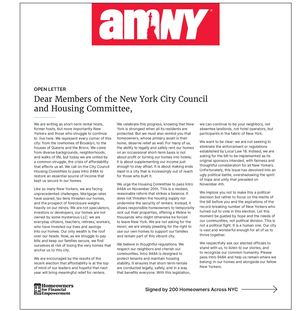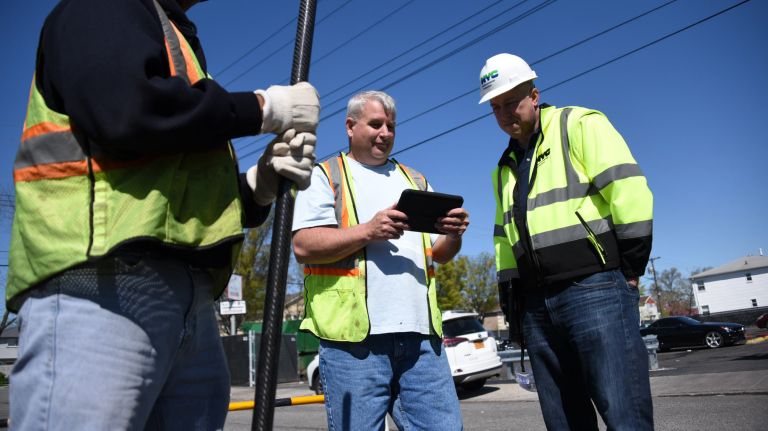
The city’s war on fatbergs is waged in the sewers but it starts in your sinks and toilets.
That’s where New Yorkers are emptying pots of grease, and flushing wipes that are a toxic recipe for disaster.
“The grease and the wipes harden up, almost like cement, and that becomes really bad,” said Tasos Georgelis, deputy commissioner for the city Department of Environmental Protection’s Bureau of Water and Sewer Operations. “You’re going to get a back up in your house and cause a back up in the city sewer system and it’s going to make an uncomfortable situation for everybody.”
Fatbergs — the name given to the product of flushed materials that do not disintegrate — have taken on an almost mythical aura in recent years with stories of enormous, congealed masses discovered in London and other parts of the U.K. But there’s nothing imaginary about the work needed to remove them, as well as the supersized price tag that comes along with them.
Every year, the city’s 311 line receives on average 12,000 reports of sewer backups. Around 3,000 are confirmed clogs in city sewers.
Georgelis said the city spends roughly $20 million dollars a year dealing with problems caused by grease and so-called flushable wipes in the sewer system that spans 7,500 miles.
“That’s taxpayer money that could go for something more appropriate,” he said.
The problem hurts property owners as well. They are responsible for their own pipes, which connect to city sewer lines. If they are filled with debris, it causes costly repairs and can lead to sewage backups.
In an effort to ward off these massive obstructions, DEP workers inspect sewers for problems and pay special attention to trouble spots across the city.
Some sites are equipped with monitors designed to measure rising water levels, an early signal of blockages.
One recent day, a DEP crew descended on a street in Howard Beach that has a history of problems. Using a camera strapped to a long pole, workers examined the pipe under a manhole cover.
“There’s grease and debris on the bench of the sewer,” Georgelis said, following the view from the camera on a tablet screen.
Even with the camera, it was difficult to determine what exactly was in the debris.
Longtime workers, like DEP construction laborers Lenny Visciano and Rich Goslin, said they have seen everything from bedsheets to needles show up in sewer pipes.
“Like gigantic bedsheets,” said Visciano. “And you wonder how it gets there.”
Goslin described chunks of grease “like a big, giant snowman.”
“It’s amazing,” he added.
Hair and dental floss are other items people don’t think twice about flushing down the toilet or rinsing into a sink drain instead of throwing in the trash.
“They think it’s going to somehow get miraculously through the system,” Georgelis said. “It’s not. It hangs over, and it grows and grows.”
He said even large objects like bicycles and bowling balls have been found in the sewers. But grease and wipes remain the DEP’s biggest foes.
“There is no such thing as a flushable wipe,” said City Councilman Costa Constantinides, who chairs the Environmental Protection Committee. “What you flush down a toilet has consequences. It doesn’t go to a magical place.”
The DEP enacted several campaigns over the years asking New Yorkers to properly dispose of grease by cooling it and putting it in the trash. The increased use of flushable wipes has made the situation even more dire.
Constantinides said he is heartened by the DEP’s new “Trash It. Don’t Flush It.” public education campaign that has been plastered all over subway walls, bus shelters and on TV.
In some unusually frank language it tells New Yorkers to only flush the four Ps, identified as poop, pee, puke and toilet paper.
“I think we can always do more,” Constantinides said. “They need more outreach in different languages and in different neighborhoods.”
Back at the site in Howard Beach, Visciano and Goslin set up their flusher truck atop a sewer opening down the road. Their goal is to send a powerful rush of water into the pipes to break up any debris and shoot it into larger pipes that will eventually lead to the wastewater treatment plant.
The water contains a grease-cutting solution similar to Dawn dishwashing detergent, which is known as a safe method for removing oil and grease from wildlife.
Wipes, grease and other material that does not break down in the water ends up collecting on screens at the city’s 14 wastewater treatment plans, where they are manually removed with rakes.
Officials from the DEP said over the last 10 years, the amount of material cleared from these screens has increased by 75%. More than 30,000 tons was removed in 2007 and over 50,000 tons removed in 2017.
They said efforts are made to contact local homeowners and remind them to throw grease and other items in the trash. Tracing clogs to local business and restaurants can be challenging, but inspectors do check grease traps.
Georgelis sees another growing concern, concrete that is poured into catch basins either unintentionally or by design. Workers have been finding hardened concrete in sewer pipes a few times a year.
“You need special equipment to chip it away,” he said. “It’s costing a lot of time and money.”


































